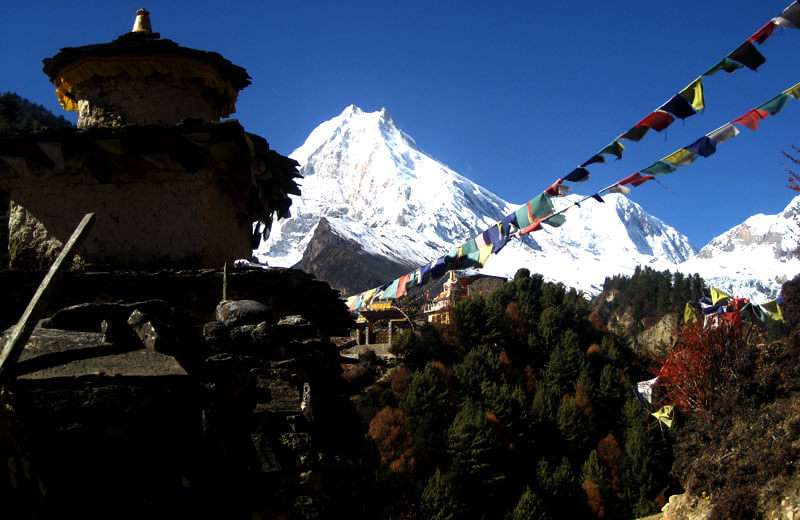Trip Overview Summery of Tsum Valley Trek with Manaslu Circuit
Manaslu and Tsum Valley Trek through the dramatically adventurous Larke Pass (5160 m) is one of the most thrilling and appealing trekking journeys in isolated and remote Shangri-La of Northern Gorkha in Nepal. This area is known as the land of monasteries, charming hamlets with rough steep tracks, and less comfortable accommodations in Tsum Valley. The area is renowned for its homestay experience, getting engaged with locals, and magnificent mountain scenery, but it is less visited. It is located in the north part of Manaslu at the Nepal-Tibet border and is remarkably popular among adventure trekking holiday fans. Just in 1991, the Manaslu region was released for foreign visitors and Tsum Valley was opened for trekkers in 2008. The area is geographically extra fabulous and culturally most attractive. The natives and locals of upper Bhudi Gandaki, a region known as ‘Nup Ri’ meaning western mountain, are direct descendants of Tibetan immigrants and they inhabited here during the early 16th century so their language, dress, and traditions are completely similar to Tibetan. The Mountain View in Nup Ri is astonishing and dramatic. Larke Pass is an exhilarating experience.
Why should you consider the Manaslu and Tsum Valley Trek?
Tsum Valley is yet to be explored and discovered; it is exactly the place to trek for the rural traveler passionate to discover an unusual part of the world than yours. The valley is a blessed with Himalayan Buddhist pilgrimage site located in the northern part of Gorkha district, Nepal. The word ‘Tsum’ refers vividly against the majestic background setting of the beautiful Ganesh Himal, Sringi Himal, and Boudha Himal ranges, and this tranquil Himalayan valley is enriched with ancient art, culture, and Himalayan Buddhist religion. It is said that the Buddhist saint Milarepa is believed to have meditated in the caves of these mountains. The valley is home to some unique and historic monasteries, mani, kaanis, and prayer walls, which lie on a pretty highland nestled in the lap of the valley, and Gompa Lungdang, located at the base of a conical hill against the main slope of Ganesh Himal. The tribes here celebrate numerous Buddhist festivals, perfume ritual burning of juniper sense to purify the air, and place prayer flags for the happiness of all the sentient living beings installed Mani Walls. The remote area has been left behind so their culture remains as it was hundreds of years ago. The trek is appealing for wilderness lovers away from their comfort zone.
What are the logistics of Manaslu and Tsum Valley Trek?
Manaslu and Tsum Valley Trek can be accomplished as a lodge trek also known as teahouse trek now while even Tsum now has several lodges, fine homestay services, and toilets available in most of the places. There are now phone call services throughout and rare mobile reception in case of an emergency. The isolated Tsum Valley side trip should not be missed if you are doing Manaslu. The area draws attention to its complete well features of the trek, with strong, friendly, welcoming locals, a living Buddhist culture, and untouched wildlife because of Buddhist prohibitions on hunting and killing. The people are poor since they have been bypassed by development for centuries, but this means their unique culture has remained ideal and intact. However, a road from China is already pegged out and will cause rapid change. Tsum is said to be a Beyul, one of the hidden valleys that 8th-century Buddhist saint and master Padmasambhava blessed as refuges to be discovered when the planet is approaching destruction and the world becomes too corrupt for spiritual practice. They are valleys reminiscent of glory and paradise, which can only be reached with enormous hardship.
Cost of Manaslu and Tsum Valley Trek Permit year 2024/2025
These controlled area permits of Manaslu and Tsum can be obtained from the Department of Immigration in Kathmandu. Both Manaslu and Tsum require separate permits. Join a registered trekking agency is obligatory to get permits and it is mandatory that you be accompanied by a licensed guide. A party of two or more foreigners should be in a group, although these requirements may be relaxed in the future. The Manaslu Trek Permit Costs are USD 100 for the first week (then USD 15 per day) for September, October, and November and USD 75 for the first week (then USD 10 per day) from December onward till August. For Tsum the same periods apply but the fee is USD 40 for the first week. You will need a TIMS card (Trekkers Information Management System) as well if you are continuing on the Annapurna Circuit through Thorong La Pass, so you’ll need 4 photos for all this. In our experience, if you are only circuiting Manaslu, your special permit means that a TIMS card is not required.
You will need two more additional permits: MCAP (Manaslu Conservation Area) NPR 3000 each and the ACAP (Annapurna Conservation Area) NPR 3000 each for the section from Dharapani to Besi Sahar after you join the round-Annapurna trail.
How are accommodations and meals on the Manaslu and Tsum Valley Trekking Route?
As there are now lodges and teahouses, you do not need to bring food and camping gear from Kathmandu, you could stay in teahouses and eat there. Wilderness Excursion arranges a local, experienced guide for your Manaslu and Tsum Valley for the entire route, to ensure that immediate benefits flow to this remote area and to get an insight into the culture.
How long is the itinerary and distance of the Manaslu trek with a Side trip to Tsum Valley?
We have crafted an 18-day itinerary; however, you can ask us to customize the trip and even you may like to add more of some other excellently recommended side trips, such as the Manaslu and Tsum Valley routes, to explore more going out of the main track that provides you with a peaceful retreat environment without others distracting your mind.








